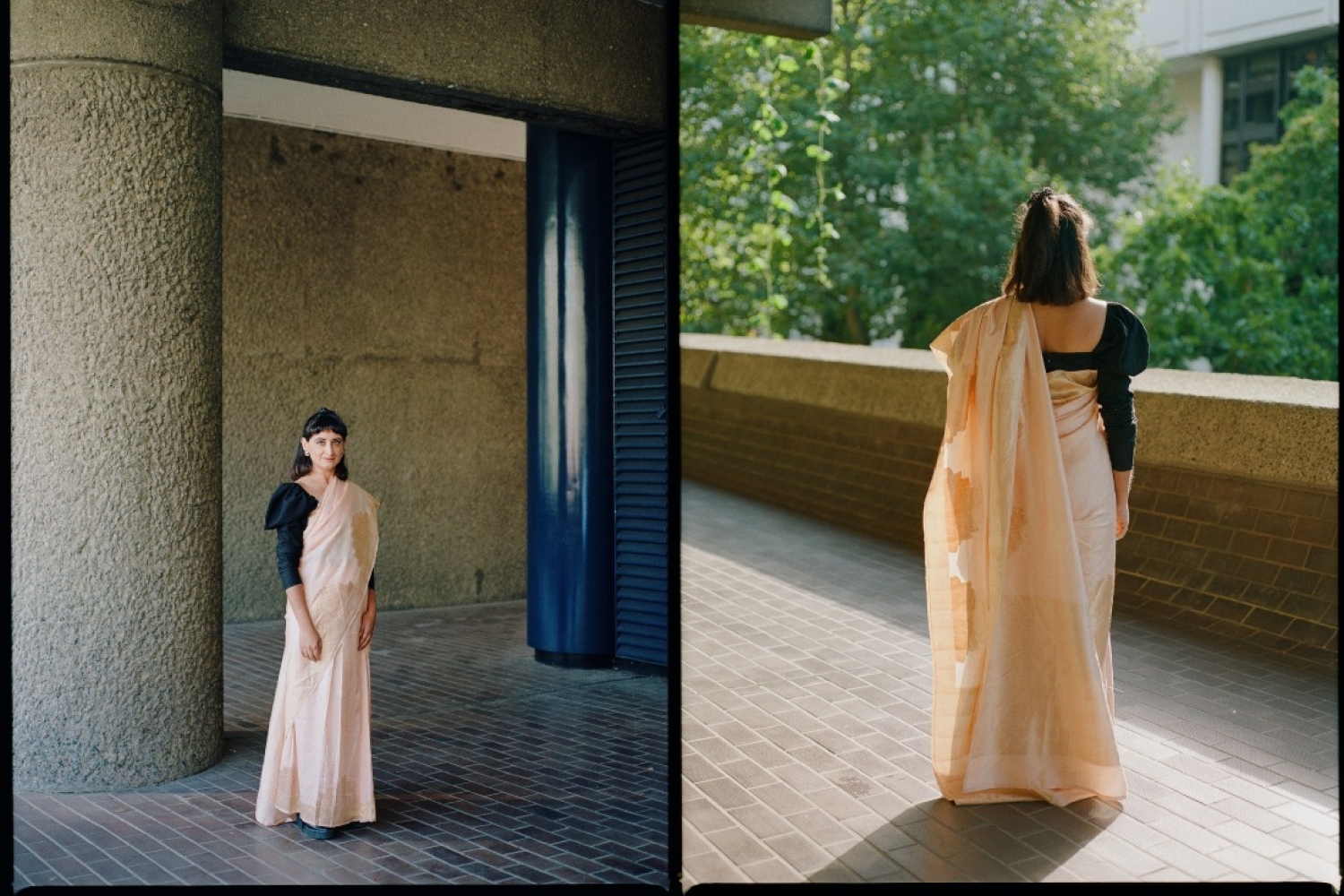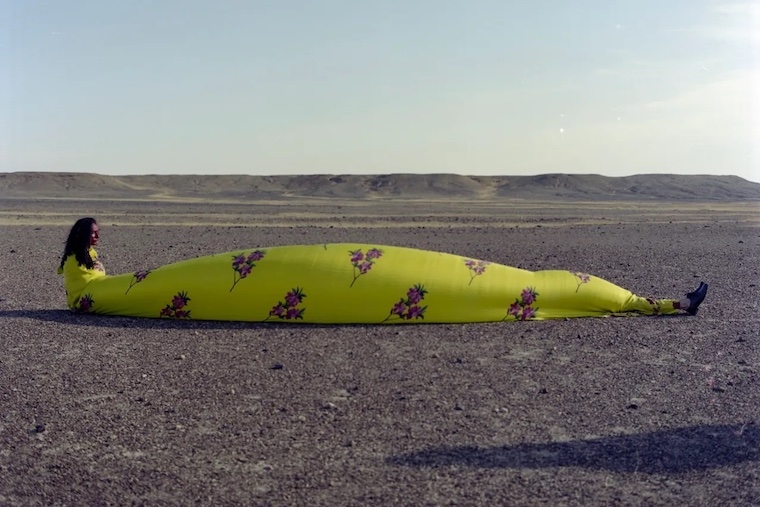
Image: Prarthna Singh

Image: Prarthna Singh
For Priya Khanchandani, writer and Head of Curatorial at the Design Museum in London, the sari is a signifier of varied facets of her identity and who she is. It is not just six yards of fabric; it is an amalgamation of collective nostalgia; hers, of the South Asian diaspora in London and elegance of the former era of her grandmother. Priya’s ongoing relationship with the garment began in her childhood. She vividly recalls hearing the melodious clinking of her grandmother’s bangles as they danced around her wrists, in the early mornings, while she gracefully wound her sari around her in preparation for her pooja. She grew up wearing it for formal occasions but also experimenting with its form, despite the popularity of the lehenga over it. The sari today is a versatile garment, it liberates one through its form and is malleable enough to be moulded into whatever the wearer wants it to be and these are the exact feelings that Priya recollects when she wore it back in the day.
The curator’s obsession with the garment has also grown recently as it has repositioned itself in the heart of Indian fashion in the past decade or so. She now sees it as a mode of expression for the youth and a means of establishing individuality through the way it is draped. Another vital aspect that Priya stresses upon, is its capacity to be indicative of the maturity of Indian design and as a design writer, she finds herself fascinated by all the experimentation being undertaken with it. It was sometime in 2015 when Priya found her way to the capital city that she analysed collections more intimately and was impressed with the idiosyncratic usage of craft to produce contemporary designs and new materiality.
Gradually, she started associating the garment with a young, cosmopolitan and chic younger woman. We’re in conversation with the curator and writer, who lets us in on thoughts revolving around the exhibition The Offbeat Sari at the Design Museum in London. It not only explores the reinvention of the sari and Indian and South Asian fashion but also features ninety saris made within the last ten years, showcasing different textures, materials, weaves, colours and drapes while examining its role in representing identity, social class and style.
Tell us about what prompted your exhibition The Offbeat Sari.
About twelve years ago, I pursued an MA at the Royal College of Art and I specialised in Contemporary Indian Design and ever since I have wanted to curate a show about Indian design in the UK. Indian design over here is still understood through the postcolonial lens or through an anthropological lens so there were exhibitions about South Asian textiles but I think the understanding of Indian within contemporary design discourse was limited. This was always something I wanted to explore and working at the Design Museum gave me the opportunity to do so. The museum is known for pushing the boundaries of contemporary design and delving into unexplored narratives. It was in 2020 when I considered working on the exhibit seriously and proposed it here. It was during the pandemic and hence I was reliant on accessing a lot of the material online before I was able to venture out for a research trip.
The idea was to be able to showcase the sari at its most innovative and creative and I wanted to show it was relevant to a contemporary design audience and how it acts as a vessel for exploring what contemporary India really is today. I decided to look at it through three aspects. The first one is transformation, this is really about the way how design is now reinterpreting the sari in a variety of ways, through structure, through form, by stitching the sari or by not stitching it, through accessorising it in different ways. The possibilities become endless, innovative drapes, denim or even with materials like recycled plastic. The second section is identity and resistance. I really wanted to be able to showcase the perspective of the wearer, the way it is being fashioned today has a lot to do with female identity, female empowerment and the way in which street culture has changed the way it’s being worn. For the second section, we specifically showcase different individuals wearing saris on the streets internationally and our aim is to show how it is shattering stereotypes of what the body can be both female, gender fluid and otherwise.
The final section is new materialities and in that I really wanted to explore contemporary craft and how new materials are emerging and redefining the sari. From metal to distilled pollution to traditional techniques like jamdani, chikankari that are being experimented with. Rashmi Varma, who has consulted with me on curating that section, has very good knowledge of what’s going on in terms of craft in India. She’s helped me shape that section and we’ve had some amazing studio visits with craftspeople via Zoom, be it ajrak block printers or indigo dyers.

Raw Mango; by Shubham Lodha
Take us through your collaboration with designer Rashmi Varma.
I brought Rashmi into the project last year when we entered the delivery phase. I’ve known her work for a long time since I lived in Delhi in 2015. I remember visiting a fashion pop up and I’d tried on one of her sari dresses. From a very early stage, her sari dress had been a part of the object list for the exhibition before I brought her on, I just had my early wishlist. I think she was a part of the group of designers at the time in Delhi who were experimenting with the sari in terms of form and reinterpreting it in a way that was lightweight, easy to wear, contemporary and very elegant.
What is it that you want for the audience to take away from the exhibit and what were some of your biggest challenges while curating it?
I think I’d really just like for them to walk into the gallery and be surrounded by beautiful objects and for that to invoke a sense of fascination. I hope it makes them feel curious but I also hope it helps challenge the stereotypes of what India is among the diasporas but also amongst a broader audience and I hope they appreciate Indian design within the contemporary context. I hope we’re able to communicate the story of the sari as being relevant today and it being a story that should be known internationally.
One of the biggest challenges I faced was obviously selecting ninety odd saris, there are thousands if not millions to actually choose from. There’s probably a sari in every household in India, not to mention other countries in the subcontinent. It is also really hard to establish a geographical scope for an exhibition like this. There is, of course, room for a bigger show including Bangladesh, Pakistan and other places we didn’t have space for unfortunately. It is also rather hard to situate the contemporary sari with its five thousand year old profound history. Then, of course, there was the challenge of geography and not being able to pop in and out of studios, which I had to overcome through background knowledge I had, through field trips and technology. Thankfully we’re in an era of Zoom and Whatsapp, I had also been in touch with the key designers regularly. I feel we’ve been able to overcome our challenges and hopefully it is worthwhile.
In today’s day and age, fashion is ever evolving and we get to explore multiple facets every now and then. What would you say is the purpose of fashion today?
I’d say it is easy to be reductive about fashion, as something that is cyclical, trend focussed and superficial. Although there’s a much broader definition of fashion I would subscribe to, the form of dressing being an expression of who we are as a society and I definitely think the sari is an amazing example of that. I think its malleability and its form of being an unstitched piece of fabric means that it adapts the persona of whoever is embodying it depending on how they’ve chosen to wear it. I think when fashion can unleash the identities of individuals, that’s when it is at its most powerful. In this case, the sari is also a canvas for immense creativity on the hand of the designers. Where the identity of the individual and the creativity of the designer come together, give rise to these amazing fireworks in terms of what fashion means.
This is an exclusive excerpt from our July EZ. To read the entire article and more such pieces, follow the link here.
Words Unnati Saini
Date 15-07-2023